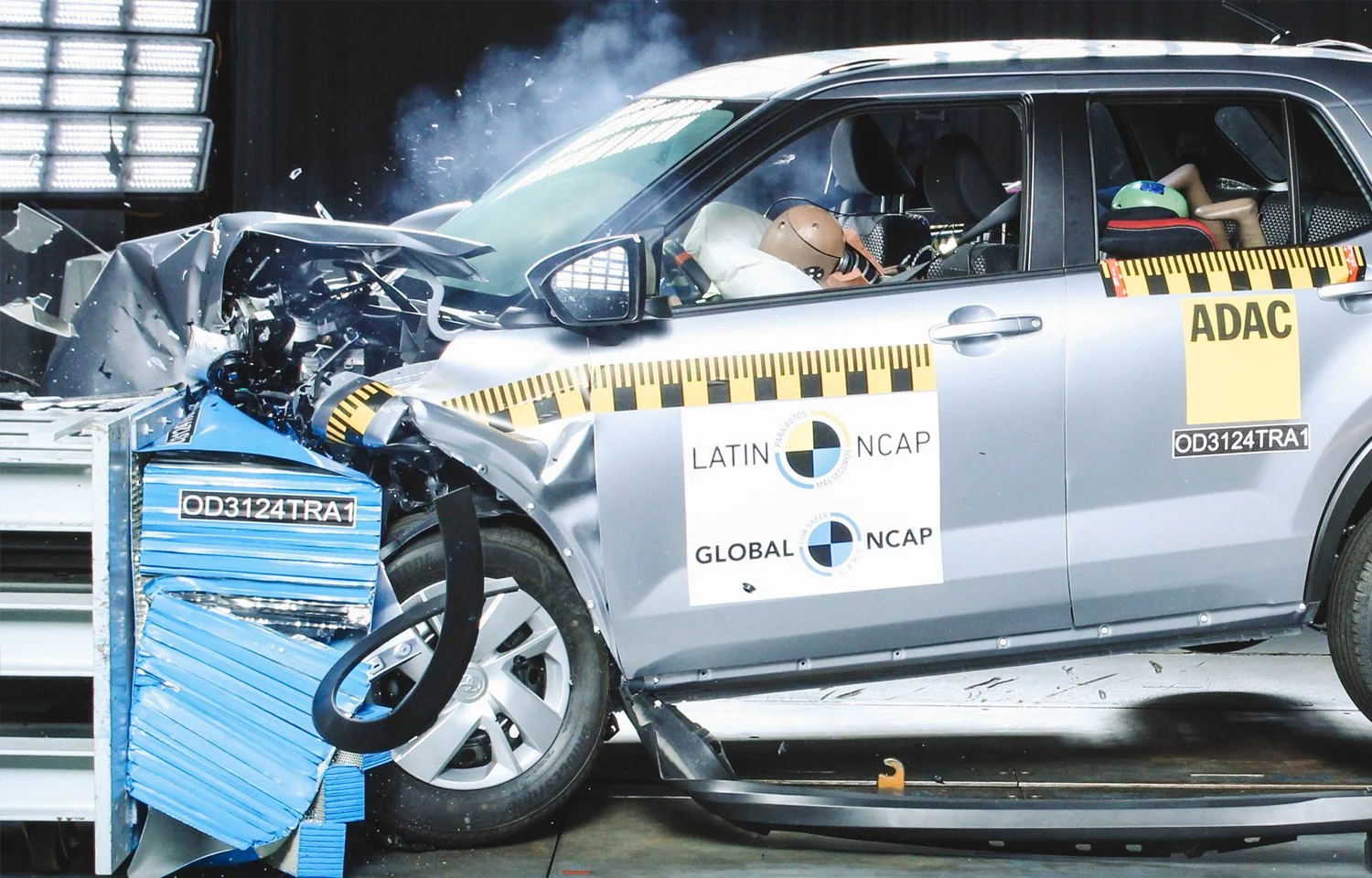Toyota disappoints with Raize while General Motors benchmarks in its segment with Montana
The New Car Assessment Programme for Latin America and the Caribbean, Latin NCAP, publishes today the first crash tests results for 2024 with a disappointing one star result for the Toyota Raize and a new segment benchmark set by Chevrolet with Montana’s three star result.
The Toyota Raize, produced in Indonesia, achieved one star. The Raize offers 2 airbags and Electronic Stability Control (ESC) as standard, achieved 40.54% in Adult Occupant, 71.57% in Child Occupant, 58.70% in Pedestrian Protection and Vulnerable Road Users and 58.14% in Safety Assist.
The car was tested in frontal impact, side impact, whiplash, pedestrian protection and ESC. The frontal impact showed unstable structure and marginal protection to driver chest. Side impact showed marginal protection to the chest and a relevant intrusion in the passenger compartment, increasing the risks of injuries to its occupants. As side head protection is not standard, side pole impact was rated with zero points and penalized for the lack of head protection in front and rear rows. The car does not offer Speed Assist Systems as standard. While Toyota offers ADAS technologies in this model for other markets, they are not offered even as optional for any of the Latin NCAP markets.
The Chevrolet Montana, produced in Brazil, achieved three stars. The Montana offers 6 airbags and Electronic Stability Control (ESC) as standard, achieved 79.18% in Adult Occupant, 71.08% in Child Occupant, 44.45% in Pedestrian Protection and Vulnerable Road Users and 65.12% in Safety Assist.
The car was tested in frontal impact, side impact, side pole impact, whiplash, pedestrian protection, speed assist and ESC. The protection to the adult occupants in the frontal crash test showed good to adequate protection with stable structure, good protection in side impact test and good head protection with marginal chest protection in pole impact test. The car does not offer Autonomous Emergency Braking (AEB) even as optional and this limited the maximum achievable score. The protection to child occupants was low in the dynamic tests due to the decision of the manufacturer to place both dummies forward facing, not following global best practices that the same car maker strictly followed for other recent models with good outcomes and even when the Child Restraint Systems (CRS) recommended and used in the test allow them to be installed rearward facing.
The model was tested as voluntary decision of the manufacturer. This result in only valid for all Chevrolet Montana produced as from VIN: 9BGEY43B0SB171251 and production date from August 23rd, 2024.
Latin NCAP tests the most basic passive safety specification of the models and strongly recommends to buy versions equipped with tested good performing ADAS technologies.
Alejandro Furas, Secretary General of Latin NCAP said:
“Chevrolet becomes again the benchmark in a popular segment, small pickups, showing good protection in comparison to the low score of its direct competitor, the Fiat Strada. We hope that Chevrolet re-considers its child occupant protection ADAS strategies as in our understanding that this car can perform better and achieve even higher star ratings. Safety leadership times of Toyota seems to be far in time as disappointing results does not seem to stop. Latin NCAP urges Toyota to change its approach, improve basic safety equipment in cars, and volunteer the cars in Latin NCAP to show consumers their performances. In a scenario of global concern about safety certifications in some Toyota cars, it is proven once again the need for a standardized vehicle safety labelling that includes the Latin NCAP star rating”.
Stephan Brodziak, Latin NCAP Chairman said:
“It is disappointing that Toyota once again engages in selling low-safety cars for certain countries in the region, such as the Raize. We know that the brand can achieve better performances in vehicle safety, so we strongly call for the company to reconsider its safety equipment strategy and subject its models to safety evaluations so that consumers know their real performance.
Regarding the Chevrolet Montana, although it is a result that indicates good passive protection for its occupants, the decision to put both child dummies rearward facing is critical, we know that it can still achieve better protection performance if driving assistance technologies are added, particularly Autonomous Emergency Braking. We invite Chevrolet to continue with these results and to set itself the goal of standardizing ADAS to improve the protection of its consumers and other road users in our region”.
Toyota Raize (2 airbags)
Read the full crash test report
Watch the crash test video
Download crash test images
Chevrolet Montana (6 airbags)
Read the full crash test report
Watch the crash test video
Download crash test images
About Latin NCAP
The Latin New Car Assessment Programme (Latin NCAP) was launched in 2010 to develop a regional system of independent crashworthiness and safety rating across Latin America and Caribbean (LAC). Latin NCAP replicates similar consumer testing programmes developed over the last thirty years in North America, Europe, Asia and Australia, and which have proved to be very effective in improving the safety of motor vehicles. Since 2010 Latin NCAP has published the results of more than 150 models, all results available at www.latinncap.com/en/results.
Latin NCAP acknowledges the support received by the Global New Car Assessment Programme (Global NCAP), International Consumer Research and Testing (ICRT), FIA Foundation, the Inter-American Development Bank (IDB) and Bloomberg Philanthropies Global Road Safety Initiative. Latin NCAP is an Associate member of Global NCAP and supports the United Nations Decade of Action for Road Safety and the Stop the Crash Partnership.
More info: www.latinncap.com





